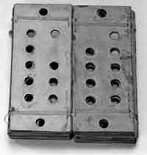There are several poetical strands in Judith Shatin’s “Penelope’s Song” that make it a worthy introduction to navigating the relationship between the electric and acoustic in performance. First, and most broadly, the idea of weaving serves at all times as a metaphor for artfully combining disparate elements into a whole.  Moreover, the repetitive, mechanical sounds of a loom make a very specific contrast with the linearity and lyricism of the violin. But that is not all: historically speaking, the loom played a surprisingly important role in the history of computation itself. The Jacquard loom, invented in 1801, used punch cards to control the patterns it produced; this idea was important for Charles Babbage’s Analytical Engine, and was used in computers up to the 1970’s. The Jacquard punch cards (shown at left) are the grandparents of the computer program; interestingly, their purpose was to create artful objects.
Moreover, the repetitive, mechanical sounds of a loom make a very specific contrast with the linearity and lyricism of the violin. But that is not all: historically speaking, the loom played a surprisingly important role in the history of computation itself. The Jacquard loom, invented in 1801, used punch cards to control the patterns it produced; this idea was important for Charles Babbage’s Analytical Engine, and was used in computers up to the 1970’s. The Jacquard punch cards (shown at left) are the grandparents of the computer program; interestingly, their purpose was to create artful objects.
The advantage of producing textiles with punch-cards is, of course, that they didn’t have to be hand-woven. The disadvantage is the same as the advantage, though: since they aren’t hand-woven, the patterns may be felt as merely mechanical. ‘Penelope’s Song’ (though it doesn’t deal with the Jacquard loom in particular) contains several shadows of this issue. Penelope’s weaving, mechanical as it is, serves to conjure up the dry days of her awaiting Odysseus’ return. There is the matter of the performer having to fight mechanical control of time by the recording, which can have a strange sterilizing quality on its passage and rhythms. So, finally, it falls to the live violin to loosen the time, to bend the narrative into habitable lyricism, and to spin pattern into fantasy,
Judith Shatin is a professor of musical composition at the University of Virginia.